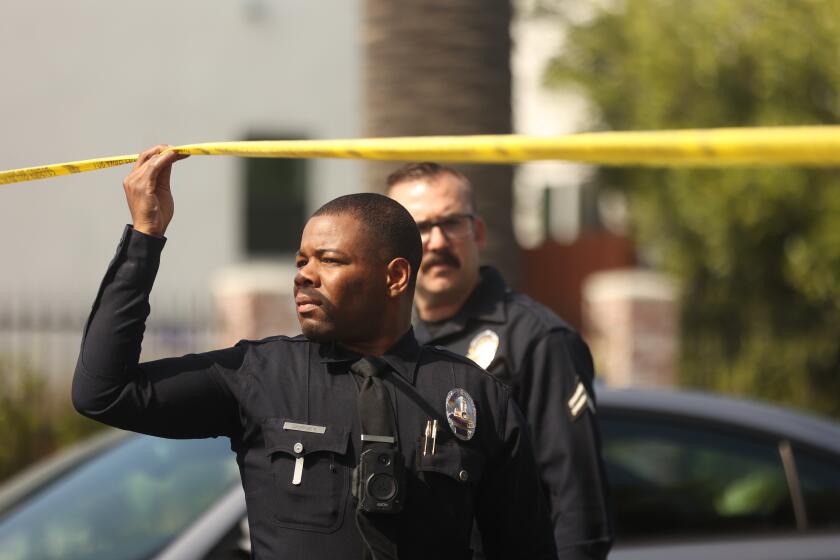Fire Burns 1,100 Acres of Brush North of Piru : Arson: Officials expect to bring the flames under control by this morning. An incendiary device has been found.
- Share via
A wind-stoked arson fire swept the dry hills north of Piru on Tuesday, consuming more than 1,100 acres of brush and drawing more than 300 firefighters from Ventura and Los Angeles counties.
Fire officials expected to bring the flames under control by this morning.
No one was seriously injured in the blaze, which threatened several oil wells but moved away from the town of Piru and toward Lake Piru, a 2,000-acre storm-water reservoir just west of the Los Angeles County line.
Members of the Ventura County Search and Rescue Team on a training mission near Modelo Canyon noticed the fire about 1 p.m. and called 911. Within 30 minutes, officials said, the blaze had grown from five acres to 200 acres.
Unpredictable 15-m.p.h. winds and rough terrain made the blaze especially difficult to fight. The Los Angeles County Fire Department brought in a pair of SuperScooper CL-215T airplanes, which scooped water out of Lake Piru and dumped it on the flames without having to land.
Every four or five minutes, the planes hauled and deposited a load of 1,500 gallons of lake water. Five other tanker planes helped douse the flames, landing after every load to refill. At least three helicopters were also used to drop lake water on “hot spots,” stopping at the base of Lake Piru dam to reload their tanks.
Firefighters from the U. S. Forest Service, California Department of Forestry and Ventura Fire Department joined in the effort along with representatives of Southern California Edison and the California Youth Authority.
Ventura County arson investigator Peter Cronk said he found an incendiary device at the source of the fire, but declined to reveal much about it.
“Whoever lit it probably had five to 12 minutes to go somewhere else before the fire took off,” Cronk said, adding that there was a timing mechanism hooked to the device. “We’ve had these types of devices used on brush fires ever since I was a firefighter--25 years.”
Cronk said investigators had located no witnesses and issued an appeal to residents or passersby who might have seen suspicious people or cars in the area before 1 p.m.
Although the fire was started along the edges of Piru Canyon Road, this main road out of the area remained passable and authorities allowed boaters to remain on the lake.
One member of the California Youth Authority’s firefighting team turned an ankle while battling the blaze, but no other injuries were reported.
After starting in Modelo Canyon, which is northeast of Piru, the blaze moved in a northeast direction toward the lake, consuming sparse button sage, wild oak and chamiza. It lapped into Piru and Blanchard canyons, leaving the hills blackened like huge mounds of coal in its wake.
Officials said most of the affected area is owned by Texaco Oil Co., which leases some acreage to sheepherders and farmers. Texaco maintains an oil lease in Blanchard Canyon, and several of the company’s oil wells and large pieces of equipment were threatened. No structures or other property were believed to have been damaged.
Many of Piru’s 1,600 residents flocked outside shortly after the blaze started, watching the smoke from town or venturing closer with video cameras.
As ash settled over their heads, several residents said the best sight was the pair of SuperScooper planes humming back and forth from Lake Piru.
“I like them a lot,” said Lonnie Ruiz, 36, who sat at a picnic table with a group of men and boys at the entrance to Piru Canyon Road. “They’re doing a good job. They don’t have to go as far as the other planes.”
Enis Choyce, 70, of Altadena was spending the day on the lake fishing for catfish when a patrol boat sped out about 1:30 p.m. Park rangers told him and boaters in the eight other vessels on the lake to clear out from the lake’s center and hug the shoreline.
Moments later, the giant yellow-and-red SuperScooper propeller planes buzzed in over the top of the dam “like dragonflies over a still pond,” Choyce said. For the next 3 1/2 hours, the fat-bellied planes dropped in every five or 10 minutes for more water.
“It was a sight,” Choyce said. “They were good pilots.”
As if they were landing, the two planes skimmed the surface for about 200 yards, then, still streaming water from their bellies, lifted off the lake. After one such maneuver, the planes followed a small spotter plane to a location on the hillside near the lake, where a corona of flames leaped from the ridgeline. Perhaps less than 100 feet from the ground, the planes--one after the other--dropped their water right on the mark. Then they circled around for more.
“These are really ideal conditions for the SuperScooper,” Los Angeles County Fire Battalion Chief Bob Grafton said. “Lake Piru is ideally suited for this. . . . The firefighters here say they’re really pleased.”
Los Angeles County is trying out the Canadian-made planes, which cost $16 million apiece, for a limited time to gauge their firefighting effectiveness.
The firefighting planes and helicopters were grounded by darkness about 7 p.m. The wind had shifted, and the fire was burning back over charred ground, officials said. A staging area along Piru Canyon Road was set to be occupied throughout the night so that the fire could be contained by this morning.
Bustillo is a Times staff writer and Hadly is a correspondent.
More to Read
Sign up for Essential California
The most important California stories and recommendations in your inbox every morning.
You may occasionally receive promotional content from the Los Angeles Times.













